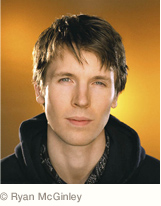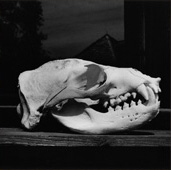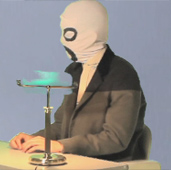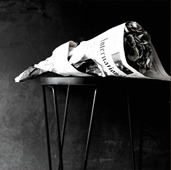
2010年までは、フィルムで撮っていた自分の写真のほうが良いと本当に信じていましたが、それは間違っていました。本当にフィルムを使ってたくさんの作品を撮ってきたので、ある日、僕のマネージャーから「節約のためにデジタルカメラで2週間撮ってみるべきだ」と勧められたんです。当初は、写真データを拡大したら画像が荒くボケてしまうんじゃないかと常に心配していたのですが、それも間違っていました。デジタルカメラは幅広い可能性を与えてくれるし、フィルム代も現像費もかからずに好きなだけ撮れる。粒子を足したり色味やハイライトを調整して、デジタル写真をフィルムで撮ったように見せるようにするのはどうすればいいかを生み出すことには少し時間がかかりましたが、今ではそれも習得しました。

洞窟は完全に暗闇でした。本当に真っ黒なんです。モデルをポーズさせて、カメラを三脚に立ててすべてセットアップしてからシャッターを2分間開放しました。僕とアシスタント全員が、カラーセロファンを付けたスポットライトを持って、シャッターを開放している間ずっと、洞窟の中を照らしていたんです。このシリーズのために、1年半以上朝から晩まで作業をしていました。
あの記事の題は、「ウォーホルの孫」であるべきだったと思います。あのフレーズを聞くと、ダッシュ・スノウのことを思い出して、彼のことを恋しく思います。僕やダン・コーレン、僕らの友人、ダウンタウン・マンハッタン、そして世界中のアート・コミュニティにとって、ダッシュの死は大きな喪失でした。早すぎました。
僕にとってダウンタウンはすべて。すべてが起こる場所です。ホームタウンであり、僕の心理をどんな風にも持っていける。一番安心できる場所、自分の仲間に囲まれていられる場所です。アーティストからクズ野郎、ゲイやレズ、変な奴まで、至るところからやって来た至る人種、至る人たち。ダウンタウンは眠らない。店は一晩中開いてるし、人々はストリートを屯しているし、バーやレストラン、コーナーのデリは24時間営業している。僕らは皆、育った街や学校に馴染めなかったから、チャンスを得た瞬間にダウンタウンへ逃げてきた。マンハッタンの25ブロック圏の“ダウンタウン”と呼ぶこの場所へ。僕の仲間たちにとって、ダウンタウンは生き様です。メンタリティであり、サブカルチャーであり、ライフスタイルなんです。ダウンタウンに住むことで、クリエイションすることへの責任を持ちます。ダウンタウンでお互いに出会うとき、本当の楽しみが始まるんです。

2012, Courtesy of the artist and Team Gallery, New York
小山登美夫ギャラリーで2シリーズ展示を行います。1つは、アメリカ中を渡った大規模で継続的な旅の中で撮影した作品です。気球から落ちる女のコ、巨大な干し草の梱を駆け抜ける男のコ、月の出を見る3人の女のコ。もう1つの展示は、「ANIMALS」です。スタジオで撮影を行い、ユーモアがある作品になっています。足が折れてギブスをはめた小さい猿。いたずら好きなネズミ、わんぱくなヤマアラシ、秘密をばらす七面鳥、水玉模様のクジャク、長い舌のトカゲ、かん高い声をあげるトラの赤ちゃん。虹のスペクトルの背景にセットしました。
京都の小山ギャラリーへ行くのを楽しみにしています。荒木経惟さんや川久保怜さんにお会いできたら夢のようだし、小野次郎さんのお寿司も食べてみたいですね。
Up until 2010 I really believed that my pictures were better because I shot them on film, I was wrong. Since I shot so much film one day my producer suggested I try to shoot digital for two weeks to save money. I was always worried that I wouldn't be able to blow up my pictures to a large scale that they might get pixelated, I was wrong. Digital offers me a wider range of possibilities and lets me shoot as much as I want for free. I don't have to think that every click I shoot will cost me money. It took me a little while to figure out how to make the digital photos look like film by adding grain and working with the colors and highlights but now I'm a master at disguising it.

The caves were totally dark, pitch black. I set up the shot, posed the model, put the cameras on a tri-pod and then clicked the shutter to open for two minutes. Me and all my assistants had spotlights with colored gels on them and illuminated the interior of the cave while the shutter was open to light the cave. We worked all day through the night most days for over a year and a half to do that series.
I always thought the title of that article should have been called 'Warhol's Grandchildren." Whenever I hear that phrase it makes me think of Dash Snow and how much I miss him. It was a huge loss to me, Dan Colen, our friends, downtown Manhattan, and the art community worldwide when Dash passed away. He left us too soon.
Downtown is everything to me, it's a place where it all goes down. It's my home but it's also my state of mind that I carry everywhere with me. It's where I feel most comfortable and am surrounded by my kind of people. The artists, the dirtbags, the fags and dykes, the weirdos, and everyone is every color and from everywhere. Downtown never sleeps. Stores are open all night, people wander the streets, bars, restaurants, corner delis are open 24/7. We didn't fit into the towns or schools we grew up in so as soon as we got a chance we all ran away to downtown. We ran away to this 25 block radius of Manhattan that we call "downtown." Downtown is a way of life for my crew. It's a mentality and a subculture, it's a lifestyle. You could be from anywhere in the world and have downtown in your heart. Living downtown we have a responsibility to create. Once we all found each other in downtown is when the real fun started.

2012, Courtesy of the artist and Team Gallery, New York

Yes I'm having two shows at Tomio Koyama's Galleries. One exhibition is photos from my extensive and constant travels throughout the United States. A picture of a girl falling from a hot air balloon, a boy running across a gigantic stack of hay bails, three girls watching the moon rise. The other exhibition is of Animals, is shot in the studio and has more of a sense of humor. A little monkeys with a broken leg in a cast, mischievous mice, naughty porcupines, turkeys that tell secrets, peacocks with polka dots, lizards with long tongues, screeching baby tigers. All set to a backdrop to a rainbow spectrum.
I'm excited to go and see Koyama's gallery in Kyoto. It would be a dream to meet Nobuyoshi Araki and Rei Kawakubo. I would like to eat sushi from Chef Jiro Ono.
Coordination by Yasuyo Hibino (Fish*co)
Translation by Ken Ikeda (concre Inc.)

2012年9月1日(土)〜9月29日(土)
小山登美夫ギャラリー東京 7F
東京都江東区清澄1-3-2-7F
Opening Reception 9月1日(土)18:00〜20:00
火曜〜日曜12:00〜19:00(日・月・祝日は休業)
http://www.tomiokoyamagallery.com
KomiyaTomio Gallery Tokyo
7F 1-3-2 Kiyosumi Koto-ku Tokyo
Opening Reception 9.1 sat 18:00 - 20:00
Tue - Sun 12:00 - 19:00
http://www.tomiokoyamagallery.com
2012, Courtesy of the artist and Team Gallery, New York

2012年8月31日〜10月1日(月)
8/ART GALLERY
/ Tomio Koyama Gallery(渋谷ヒカリエ8F)
東京都渋谷区渋谷2-21-1 渋谷ヒカリエ8F
11:00〜20:00(会期中無休)
http://www.tomiokoyamagallery.com
2012.8.31 fri - 10.1 mon
8/ART GALLERY / Tomio Koyama Gallery
Shibuya Hikarie 8F 2-21-1 Shibuya Shibuya-ku Tokyo
11:00 - 20:00
http://www.tomiokoyamagallery.com
2012, Courtesy of the artist and Team Gallery, New York

ライアン・マッギンレー : 1977年、アメリカ・ニュージャージー州ラムジー生まれ。フォトグラファー。自由で過激、時に純粋でもある桃源郷のような世界の作品を手掛ける時代の寵児。2000年、弱冠22歳でNY・ローワーイストサイドに住む友人たちのリアルな生活を撮影したシリーズで、初の自主企画の個展を開催。同時に自費出版した作品集『The Kids Are Alright』が話題になり、その3年後にはホイットニー美術館で同館史上最年少の作家として個展を開催。作品はグッゲンハイム美術館、サンフランシスコ近代美術館、ヒューストン美術館、スミソニアン美術館・国立肖像美術館(ワシントン)をはじめ、さまざまなミュージアムに所蔵されている。
http://ryanmcginley.com
Born in 1977 and grown up in NJ. Ryan McGinley's utopian photographs, with their subtle but strong sense of composition and color, capture the essence of his generation. In 2000, at the age of 22, McGinley opened a guerrilla show of color photographs depicting moments in the lives of the people around him, members of New York's Lower East Side youth culture. He also produced a 50-page book of these photographs, lovingly titled The Kids Are Alright, which attracted widespread attention and ultimately led to a solo show at The Whitney Museum of American Art, making him the youngest artist ever to receive this honor. McGinley's photographs are included in the collections of The Solomon R. Guggenheim Museum, the San Francisco Museum of Modern Art, the Museum of Fine Arts in Houston, the Smithsonian National Portrait Gallery in Washington D.C., and many others.




























